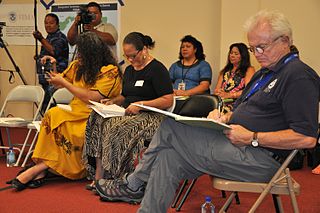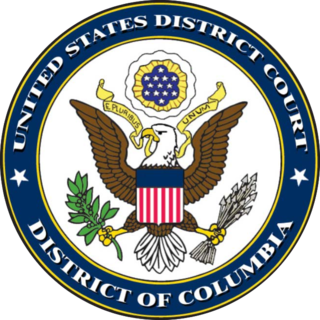Related Research Articles
A class action, also known as a class-action lawsuit, class suit, or representative action, is a type of lawsuit where one of the parties is a group of people who are represented collectively by a member or members of that group. The class action originated in the United States and is still predominantly a U.S. phenomenon, but Canada, as well as several European countries with civil law, have made changes in recent years to allow consumer organizations to bring claims on behalf of consumers.
In legal terminology, a complaint is any formal legal document that sets out the facts and legal reasons that the filing party or parties believes are sufficient to support a claim against the party or parties against whom the claim is brought that entitles the plaintiff(s) to a remedy. For example, the Federal Rules of Civil Procedure (FRCP) that govern civil litigation in United States courts provide that a civil action is commenced with the filing or service of a pleading called a complaint. Civil court rules in states that have incorporated the Federal Rules of Civil Procedure use the same term for the same pleading.

Public relations (PR) is the practice of managing and disseminating information from an individual or an organization to the public in order to affect their public perception. Public relations (PR) and publicity differ in that PR is controlled internally, whereas publicity is not controlled and contributed by external parties. Public relations may include an organization or individual gaining exposure to their audiences using topics of public interest and news items that do not require direct payment. The exposure mostly is media based. This differentiates it from advertising as a form of marketing communications. Public relations aims to create or obtain coverage for clients for free, also known as earned media, rather than paying for marketing or advertising also known as paid media. But in the early 21st century, advertising is also a part of broader PR activities.
A lawsuit is a proceeding by a party or parties against another in the civil court of law. The archaic term "suit in law" is found in only a small number of laws still in effect today. The term "lawsuit" is used in reference to a civil action brought by a plaintiff demands a legal or equitable remedy from a court. The defendant is required to respond to the plaintiff's complaint. If the plaintiff is successful, judgment is in the plaintiff's favor, and a variety of court orders may be issued to enforce a right, award damages, or impose a temporary or permanent injunction to prevent an act or compel an act. A declaratory judgment may be issued to prevent future legal disputes.
A strategic lawsuit against public participation (SLAPP), SLAPP suit, or intimidation lawsuit is intended to censor, intimidate, and silence critics by burdening them with the cost of a legal defense until they abandon their criticism or opposition.
Malicious prosecution is a common law intentional tort. Like the tort of abuse of process, its elements include (1) intentionally instituting and pursuing a legal action that is (2) brought without probable cause and (3) dismissed in favor of the victim of the malicious prosecution. In some jurisdictions, the term "malicious prosecution" denotes the wrongful initiation of criminal proceedings, while the term "malicious use of process" denotes the wrongful initiation of civil proceedings.
In law, a settlement is a resolution between disputing parties about a legal case, reached either before or after court action begins. The term also has other meanings in the context of law. Structured settlements provide for future periodic payments, instead of a one time cash payment.
Prejudice is a legal term with different meanings when used in criminal, civil, or common law. In legal context "prejudice" differs from the more common use of the word and thus has specific technical meanings.
Forum shopping is a colloquial term for the practice of litigants having their legal case heard in the court thought most likely to provide a favorable judgment. Some jurisdictions have, for example, become known as "plaintiff-friendly" and so have attracted litigation even when there is little or no connection between the legal issues and the jurisdiction in which they are to be litigated.
Reputation management refers to the influencing and controlling or concealing of an individual's or group's reputation. Originally a public relations term, the growth of the internet and social media, led to growth of reputation management companies, made search results can make core part of an individual's or group's reputation. Online reputation management, sometimes abbreviated as ORM, focuses on the management of product and service search website results. Ethical grey areas include mug shot removal sites, astroturfing customer review sites, censoring negative complaints, and using search engine optimization tactics to influence results. In other cases, the ethical lines are clear; some reputation management companies are closely connected to websites that publish unverified and libelous statements about people. The reputation management companies charge thousands of dollars to remove these posts – temporarily – from their websites.
A legal remedy, also referred to as judicial relief or a judicial remedy, is the means with which a court of law, usually in the exercise of civil law jurisdiction, enforces a right, imposes a penalty, or makes another court order to impose its will in order to compensate for the harm of a wrongful act inflicted upon an individual.
A legal case is in a general sense a dispute between opposing parties which may be resolved by a court, or by some equivalent legal process. A legal case is typically based on either civil or criminal law. In most legal cases there are one or more accusers and one or more defendants. In some instances, a legal case may occur between parties that are not in opposition, but require a legal ruling to formally establish some legal fact, such as a divorce.

The judicial system of Egypt is an independent branch of the Egyptian government which includes both secular and religious courts.
Corporate communication is a set of activities involved in managing and orchestrating all internal and external communications aimed at creating favourable point of view among stakeholders on which the company depends. It is the messages issued by a corporate organization, body, or institute to its audiences, such as employees, media, channel partners and the general public. Organizations aim to communicate the same message to all its stakeholders, to transmit coherence, credibility and ethics.
A personal injury lawyer is a lawyer who provides legal services to those who claim to have been injured, physically or psychologically, as a result of the negligence of another person, company, government agency or any entity. Personal injury lawyers primarily practice in the area of law known as tort law. Examples of common personal injury claims include injuries from slip and fall accidents, traffic collisions, defective products, workplace injuries and professional malpractice.
The legal system of South Korea is a civil law system that has its basis in the Constitution of the Republic of Korea. The Court Organization Act, which was passed into law on 26 September 1949, officially created a three-tiered, independent judicial system. The revised Constitution of 1987 codified judicial independence in Article 103, which states that, "Judges rule independently according to their conscience and in conformity with the Constitution and the law." The 1987 rewrite also established the Constitutional Court, the first time that South Korea had an active body for constitutional review.

Canadian defamation law refers to defamation law as it stands in both common law and civil law jurisdictions in Canada. As with most Commonwealth jurisdictions, Canada follows English law on defamation issues.
Legal financing is the mechanism or process through which litigants can finance their litigation or other legal costs through a third party funding company.
Prenda Law, also known as Steele | Hansmeier PLLP and Anti-Piracy Law Group, was a Chicago-based law firm that ostensibly operated by undertaking litigation against copyright infringement. However, it was later characterized by the United States District Court for Central California in a May 2013 ruling as a "porno-trolling collective" whose business model "relie[d] on deception", and which resembled most closely a conspiracy and racketeering enterprise, referring in the judgment to RICO, the U.S. Federal anti-racketeering law. The firm ostensibly dissolved itself in July 2013 shortly after the adverse ruling although onlookers described Alpha Law Firm LLC as its apparent replacement. In 2014, the ABA Journal described the "Prenda Law saga" as having entered "legal folklore".

Klayman v. Obama was an American federal court case concerning the legality of the bulk collection of both phone and Internet metadata by the United States.
References
- 1 2 3 4 Haggerty, J. F. (2003). In the court of public opinion: Winning your case with public relations. Hoboken, NJ: Wiley.
- ↑ Goldstein, Matthew; Vogel, Kenneth P. (2018-11-13). "A Fugitive Financier's Charm Offensive Has P.R. Firms Proceeding With Caution". The New York Times. ISSN 0362-4331 . Retrieved 2020-06-24.
- ↑ "USA: An Introduction to PR & Communications Law | Chambers and Partners". chambers.com. Retrieved 2021-09-15.
- 1 2 3 Reber, B. H., Gower, K.K., & Robinson, J. A. (2006). The Internet and litigation public relations. Journal of Public Relations Research, 18(1), 23-44.
- 1 2 Maltin, T. (2018). The role of litigation PR both inside and outside the courtroom. In-House Lawyer
- ↑ Haywood, R. (2002). Managing your reputation: How to plan public relations to build and protect the organization's most powerful asset (2nd ed.). London: Hogan Page.
- 1 2 Fitzpatrick, K. (1996). Practice management: The court of public opinion. Texas Lawyer, P.30.
- ↑ Hantler, S. B., Schwartz, V. E., & Goldberg, P.S. (2004). Extending the privilege to litigation communication specialties in the age of trial by media. Communication Law Conspectus, 13, 7-34. p. 8
- 1 2 Gibson, D. C. (1998). Litigation public relations: Fundamental assumption. Public Relations Quarterly, 43, 19-23.
- ↑ Schweitzer, M. L. (2003). A matter of judgment. New York Law Journal, p. 26.